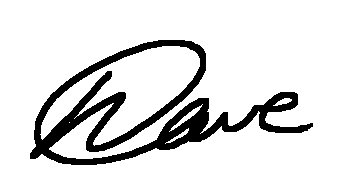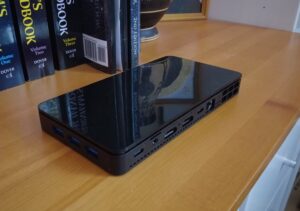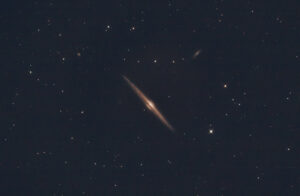When I first began my astrophotography journey, I really enjoyed the struggle with learning how to focus with a bahtinov mask, learning how to center my mount on the target – initially with manual slews and finally with APT using plate solving to determine where I was pointed at and where I needed to be. And I enjoyed changing my filters (my first “astrophotography” camera was my Sony A7rIII, soon to be followed up with a perennial favorite amnog astrophotographers, the Canon EOS T3i).
And boy did I enjoy the struggle with getting all the drivers and all the software to talk and work together. It was a problem that needed to be solved, and so I put myself into solving the issues as they arose. . .
Then one night, everything worked as it was supposed to, and it went pretty smoothly.
Then the next night, everything worked again.
And again . . . and again.
The Autofocus Monster
So I decided that perhaps it was time to begin implementing some additional features and functionality. I know that one of my personal goals was moving from manual focusing to autofocusing. And so I purchased a ZWO EAF.
The little red box came, and it took some struggle getting it on my focuser. But the real fun began when I at the same time decided to move from APT to Nina.
I think a good lessons learned is not to introduce a lot of change at the same time. I not only struggled to figuring out Nina – way, way different from using APT! – to figuring out the focus parameters to use in Nina to get autofocus working to a point where I could replicate a good focus curve.
This took me about three months. Seriously, three months!
Three months of lost imaging time as I struggled with understanding Nina and figuring out the focus parameters I needed for my telescopes’ focuser and the ZWO auto focuser.
But I got it figured out! But it was – wait for it – a struggle.
You will see that the concept of everything being a struggle is pretty much my experience with astrophotography.
I didn’t yet have the dream of automating my astrophotography sessions, but I was steadily putting the pieces into play. But I didn’t see that at the time.
Monochrome Astrophotography Camera, Oh My!
Shortly after I got my focusing beating into submission, I decided that it was time to move from my Sony A7rIII and my Canon EOS 3Ti to a dedicated astrophotography camera.
And I don’t do things halfway, no, not I!
I decided to jump into the deep end of the astrophotography pool and get myself a monochrome camera with a filter wheel and LRGB and SHO filters to boot.
Yea. It really did make sense at the time. But looking back at it know I just wonder what in the world was I thinking!
ZWO had just announced the new camera (new at that time) the ZWO ASI2600MM Pro. And I knew that I had a choice to make, either pick up the new camera or work with the ZWO ASI1600MM Pro.
As a landscape photographer, I knew instinctively that the larger the sensor the better the final image.
That is one thing that I have learned since starting this hobby, what applies to landscape photography doesn’t necessarily apply the same way to astrophotography.
So the new camera, 7 position 2″ filter wheel, and ZWO LRGB and SHO 12nm filters showed up on my doorstep.
And I went to town to put this stuff together.
And I spent another three months trying to get it all working in Nina (there really wasn’t much on either YouTube or on websites to answer all of my questions).
And during that struggle (there is that funny word again, SMH), the thought began to creep into my head every now and then, “wouldn’t it be nice if I could setup a sequence in Nina and everything just worked and I could capture all my light frames while I slept?”.
Yea.
But I as often as the thought would wander through the maze of my mind, more “important” items would hit me like how do I create autofocus offsets for my new filters, or why are there halos around my bright stars from my OIII filter, or how do I setup this %^#$@* sequence so that it will actually run!
You know, the important stuff!
Lessons Learned and the Dream is born
Anyways, I look back at that year and I don’t have very many astro photographs from that year. But I did learn a lot about software, learning how to use ASCOM to get everything to talk, beginning my lessons in the arcane world of guiding (here’s looking at you PHD2!), software drivers, hardware, hardware settings, creating sequences in Nina that actually would work, and getting everything to just talk and communicate with each other.
I learned at the end of that year of immense struggle, that astrophotography is really being part engineer, part software developer and part magician. And I was reminded, almost on a daily basis of Arthur C. Clarke’s axiom, “Any sufficiently advanced technology is indistinguishable from magic,” and of course the maxim I knew from working in IT for over 20 years, that sometimes we don’t know why stuff works, and if it works, it is “PFM” – pure fucking magic.
Somehow I was able to get everything pretty much working – I often didn’t know how (PFM was frequently on my mind those days as an explanation as to why something worked the 21st time I tried it but didn’t work the prior 20 times, go figure).
And of course, just in time for the heat of the summer to hit, ending quickly my imaging season for that year.
Which left me with way too much time on my hands and time to dream . . . of automating my capture process.
I work full time as an IT project manager, and I am up at 4:30 so that I can be on line and ready for work at 5am. I don’t have time to stay up all night and babysit my astrophotography rig.
So the thoughts from the previous year suddenly made a comeback in my mind, “What if I could automate the capture process? Wouldn’t it be great to just kick it off and come back the following morning and find a directory full of subs ready for stacking?”
Oh man, I really got excited at the thought! And I began to seriously consider the possibility as well as seriously consider the process to implement the “dream” as I began to call it. . .



